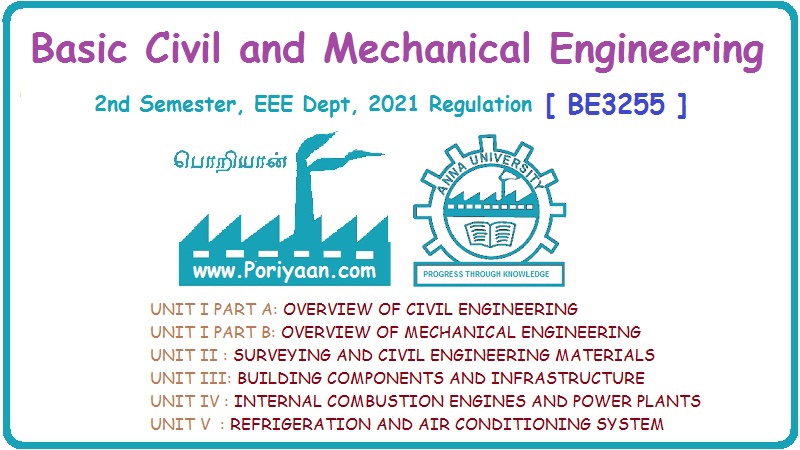Basic Civil & Mechanical Engineering: UNIT III: j. Bridges
Steel bridges
Types, Structural Diagram, Advantages | Civil Engineering
Various types of steel bridges are: 1. Steel Truss Bridges 2. Steel Arch Bridges 3. Steel Rigid Frame Bridges 4. Steel Bow String Girder Bridges 5. Suspension Bridges 6. Movable Steel Bridges
STEEL BRIDGES
Steel
Bridges are provided with steel beam cross sections for longer spans and
heavier loads. Deeper and stronger sections in steel can be built up by
riveting or welding together a combination of steel plates and steel angles.
This is known as Plate Girder. Steel bridges are used for a wide range of
spans. They are constructed in highways, railways, etc. Various types of steel
bridges are:
1.
Steel Truss Bridges
2.
Steel Arch Bridges
3.
Steel Rigid Frame Bridges
4.
Steel Bow String Girder Bridges
5.
Suspension Bridges
6.
Movable Steel Bridges
1. STEEL TRUSS BRIDGES
A
Steel Truss Bridge consists of two trusses – one on either side of a road way
with floor members placed between them. These type of bridges are used
economically in the span range of 100 to 200 m. Advantages are:
(i)
Simple Steel Sections: Primary forces in its members are axial forces.
Therefore, simple steel sections are enough.
(ii)
Light Weight Members: The construction and erection of a steel truss
bridge are considerably simplified due to the light weight of its members.
(iii)
Wind Pressure: These bridges are not affected by wind pressure.
Therefore, they are used for long railway bridges, highway bridges, water
pipes, gas or oil pipes, etc.
Types
of Steel Truss Bridges
See
Fig. 9. Steel truss bridges are supported on Abutments on either side by means
of bearings. The chord on the top surface of the truss is known as Top Chord.
The chord on the bottom surface is known as Bottom Chord. Various types of
steel truss bridges are:
(i)
N-Truss Bridge [Fig. (i)]
(ii)
K-Truss Bridge [Fig. (ii)]
(iii)
Through Warren Truss Bridge (Fig. (iii)]
(iv)
Warren Low Truss Bridge with Stringers [Fig. (iv)]
(v)
Curved Chord Warren Truss Bridge [Fig. (v)]
(vi)
Dick Warren Truss Bridge [Fig. (vi)]
(vii)
Pratt Low Truss Bridge [Fig. (vii)]
(viii)
Curved Chord Pratt Truss Bridge [Fig. (viii)]
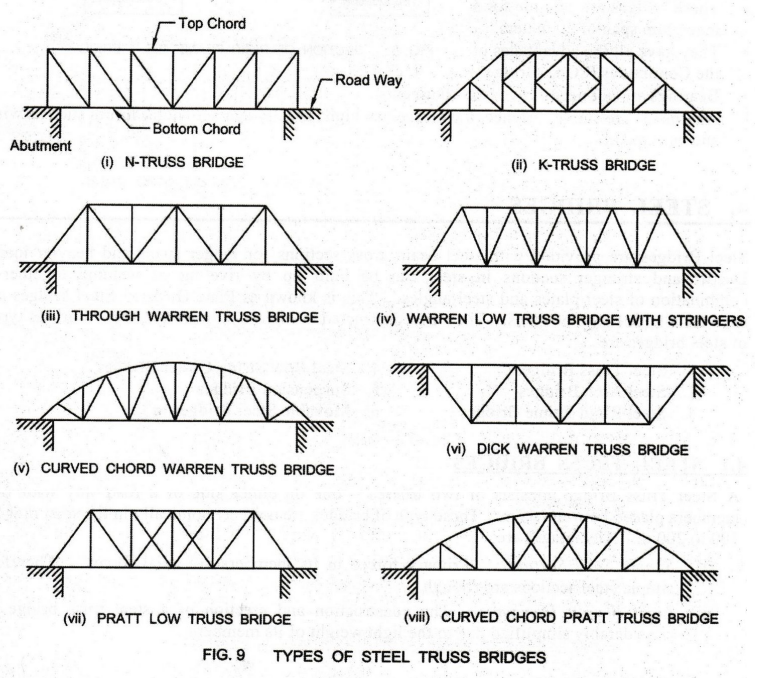
2. STEEL ARCH BRIDGES
Steel
Arch Bridges are used for very long single spans to a maximum of 150 meters.
These are constructed in places where it is not possible to construct
intermediate piers. Steel arches may be either of the Trusses Arch Type or
Spandrel Brazed Arch Type. They consist of trusses or plate girders used in the
form of curved beams, called Arch Ribs. They may be fixed, two hinged or three
hinged.
See
Fig. 10. Types of steel arch bridges are: (i) Truss Type Arch, (ii) Two Hinged
Steel Arch (iii) & (iv) Open Spandrel Steel Arches
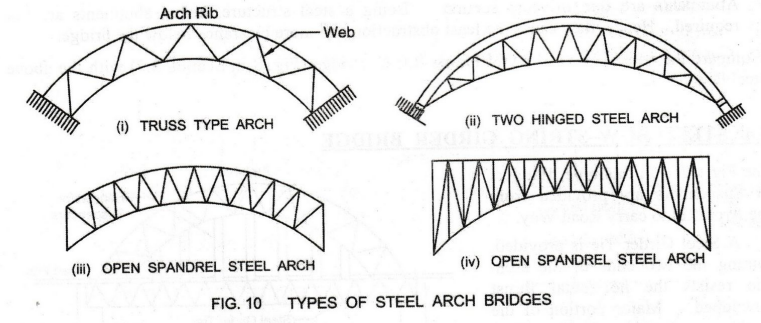
3. STEEL RIGID FRAME BRIDGE
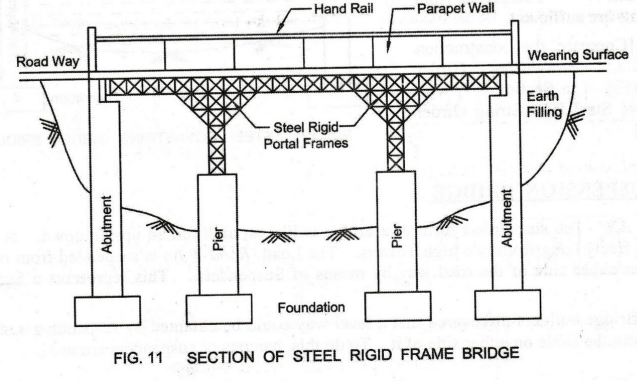
See
Fig. 11. In this type, Steel Rigid Portal Frames are used for the bridge
construction and hence the name Steel Rigid Frame Bridge. Both the
superstructure and substructure are built together to form a monolithic Steel
Portal Frame.
The
portals may be single or multiple of plate girders. These bridges have a number
of parallel girders connected to the supporting Piers and Abutments. They are
spaced along the width of the bridge. Flooring (Road Way) is supported over the
portal frame.
Advantages
• This type of bridge is well suited
where the distance between the two road ways is restricted and where the cost
of excavation for the abutments is high.
• Bearings are not required.
•
This
bridge has more clearance below it due to thin steel frames.
•
Abutments are thin in cross section. Being a steel structure, heavy abutments
are not required. Hence, they cause the least obstruction and more clearance
below the bridge.
[Compare
the construction of Rigid Frame R.C.C. Bridge (Fig. 8 in Section 3.7) with the
above Steel Rigid frame bridge.]
4. STEEL BOW-STRING GIRDER BRIDGE
See
Fig. 12. In this type, Hangers or Suspenders are provided from the Arch Rib to
carry Road Way.
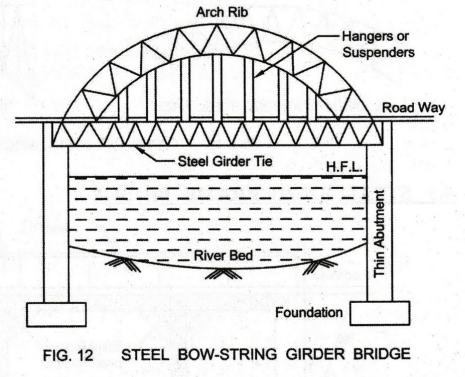
A
Steel Girder Tie is provided, joining the two ends of the arch. Tie resists the
horizontal thrust developed. Major portion of the load is supported by the tie.
This results in less thrust on the Abutments. Therefore, thin abutments are
sufficient.
[Compare
the construction of R.C.C. Bow-String Girder Bridge (Fig. 4 in Section 3.3)
with the above Steel Bow-String Girder Bridge.]
5. SUSPENSION BRIDGE
See
Fig. 13. The suspension form of a bridge is like an arch turned upside down. A
flexible Cable is freely hung from two high Towers. The Load (Road Way) is
suspended from two main cables on either side of the road way by means of
Suspenders. This represents a Suspension Bridge.
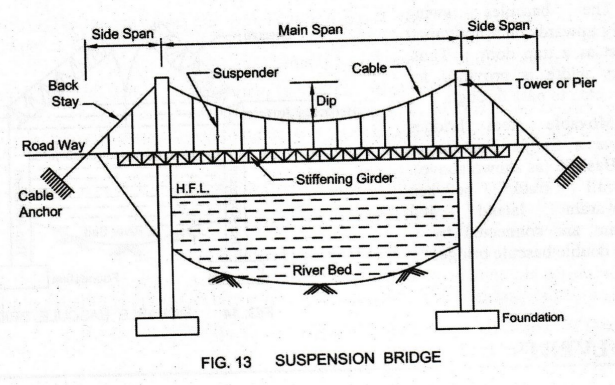
Bridge
builders discovered that a level-way could be obtained by suspending a
stiffening girder from the cable on either side of it. To do this, hangers or
suspenders are used.
The
suspension bridge has the following components: Two flexible cables, Back stay,
Towers or piers, Suspenders, Stiffening girder, Cable anchors, etc. The cable
should be made of high tensile steel. The tower is built of steel and concrete.
Suspension
Bridge is suspended on two Cables on each side of the Road Way. The cables are
anchored at the ends by means of Cable Anchors as shown.
For
heavy loads, stiffening is required to prevent vertical distortions. For this,
Stiffening Girder is provided at the road way. Stiffening Girder is an
all-welded steel stiffened box girder. Sometimes, two Side Spans are also added
in addition to the main central span. The side spans are suspended from the
Back Stays.
Advantages
• Suspension Bridges are used in
places where it is difficult to adopt other types of bridges.
• They are economically used for long
spans of more than 500 meters. Generally, they are single span bridges. The
world's longest span bridge at present is the Akashi Kaikyo Bridge in Japan. It
is a suspension bridge with a main span of 1990 meters.
•
Suspension bridge is much lighter than any other bridge.
6. MOVABLE STEEL BRIDGES
A
Movable Bridge is one that can be changed in position so as to open or clear
the passage for ships, boats, vessels, streams, etc.
Movable
steel bridges are used over the navigation channels where permanent and
sufficient clear water way cannot be provided. They provide a passage of
necessary width and clearance for the ships, vessels, steamers or boats.
See
Fig. 14. It shows a movable steel bridge, called Bascule Bridge. Two bascules
are provided just below the road way. They are supported by thin Abutments.
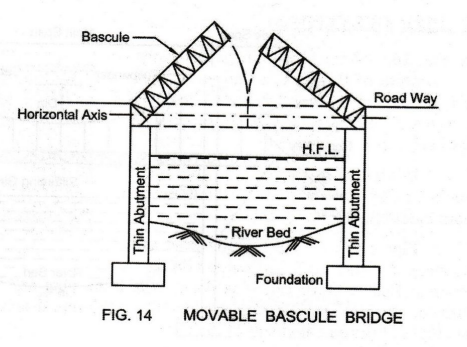
The
bascules swing vertically upwards on a horizontal axis, just as a trap door.
Thus, necessary width is provided for the ships etc., to pass through.
Movable
steel bridges may have a Single Bascule or Double Bascule (as shown above). The
rail track between Rameshwaram Island and Mandapam are connected by a movable
double bascule bridge.
Basic Civil & Mechanical Engineering: UNIT III: j. Bridges : Tag: : Types, Structural Diagram, Advantages | Civil Engineering - Steel bridges
Related Topics
Related Subjects
Basic Civil and Mechanical Engineering
BE3255 2nd Semester 2021 Regulation | 2nd Semester EEE Dept 2021 Regulation
